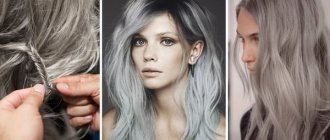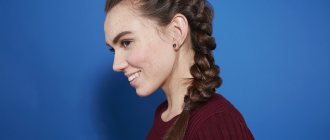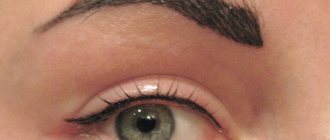Who is suitable for highlighting through a cap?
This type of curl lightening is ideal for owners of short haircuts of any color. At the same time, the hair should be quite healthy and moisturized. It is not advisable to dye hair that is too dry, brittle or falling out.
Coloring with a cap is suitable for short haircuts.
In addition, the strands must be completely free from dye of any kind - from traditional full dyeing to color changes using tonics, henna or tinted shampoos.
Highlighting done in this way is perfect for women of any type of appearance, age and any color type. The variety of types of coloring that can be reproduced using such a hat allows each woman to choose her ideal option.
Important! Very long curls, below the shoulder blades, can be quite difficult to pull through small holes, so foil or an open method is usually used for long hairstyles. Dyeing long hair with a cap can be justified in cases where it is necessary to highlight only a couple of strands
Where do you want to highlight?
In the salonAt home
Who shouldn't try coloring?
Despite its versatility, ombre is not for everyone. The procedure should be abandoned
- Girls with severely damaged, split ends, brittle hair. The effect of burnt strands is good if the hair is in perfect condition, otherwise the hairstyle will look untidy. A contrasting and colored ombre will highlight the poor condition of the hair.
- For those with very oily strands. The greasy roots against the background of the bleached strands will be striking. For a normal hairstyle, you will have to wash your hair every day, but this does not always save the situation.
https://youtu.be/https://youtu.be/xIGq1f0mT0s
_
Stages of highlighting
Comb your hair, put on the prepared cap and begin pulling strands through the holes in the cap. Try to get strands of equal width. When using a store-bought cap, strands can be taken out from each hole, or at intervals (medium and intense highlighting), depending on the desired result. It is more effective to dilute the composition in a container after threading the strands through a cap - this way you will work with freshly prepared mass, and this will improve the result. Apply the prepared mixture to the strands threaded through the holes of the cap. When applying, work with light movements, never crumple the strands to prevent smudges through the holes in the cap. To enhance the effect, it is sometimes recommended to use plastic film - this increases thermal insulation, thereby accelerating the chemical reaction for lightening. The waiting time is usually indicated in the instructions for the lightening agent. The interval may vary depending on the hardness and original color of the hair. Typically the procedure time is from 15 to 45 minutes
It is important to maintain the recommended interval, otherwise the hair may be damaged or the result may not meet expectations. You should independently monitor the progress of lightening: due to the increased porosity of the hair, the effect may occur earlier than the stated time. At the end of the procedure, the lightening cream should be thoroughly rinsed from the hair without removing the cap.
Next, free your head from the headdress and wash your hair again with shampoo and conditioner to nourish it after lightening. Hair restoration is necessary after any lightening, so this stage should never be ignored. Home highlighting kits often contain nourishing masks for post-procedure care. The final stage is tinting the strands, which is necessary to soften and prevent visual changes in color. It is better to carry out this work at least three days after lightening; you should not overload your hair with unnecessary chemicals.
- It is not recommended to use previously highlighted strands when re-dying; this can harm the quality of the hair structure.
- You should not wash your hair before dyeing; this will create a natural protective effect that allows you to resist the negative effects of the oxide.
- Any lightening does not require preliminary preparation in the form of moisturizing the scalp
- To prevent the occurrence of an allergic reaction, it is better to conduct a test reaction on a small area of the hand, according to the instructions for the coloring composition.
- For thin and weakened hair, do not rush into the lightening process; it is advisable to thoroughly treat the hair first.
- The thinner the “feathers” are when threaded through the cap, the more natural the result will be.
- There are classic highlighting and zonal highlighting. The first type involves coloring the entire length of hair threaded through the cap. Zonal – work is carried out with individual sectors. It opens up wide possibilities for creativity: “asymmetry”, “diagonal”, root application of the coloring composition, “avant-garde” and many other types of intermediate coloring.
As a rule, highlighting through a cap on short hair (the photo shows the result of dyeing in the article) turns out no worse than when carrying out the procedure in a salon. If the result does not suit you, it will be easy to fix it. But with long hair everything is more serious. If you are not sure of success, it is better not to take risks, but trust the specialists in the salon!
Common mistakes when styling long hair
Express method
There are a number of simple rules when forming large and small curls:
- To eliminate unsightly creases at the ends when using a curling iron or hair straightener, we form a curl from the root, smoothly moving the plates from top to bottom, leaving the ends about five centimeters long, not curled. If desired, they can be formed up or down later;
- The varnish is applied after curling, tilting the head down and spraying closer to the roots. If you spray from above, the volume under the weight of the styling will be completely destroyed;
- thin hair and small curls do not tolerate strong hold hairspray. You need products from 1 to 3 (light or medium hold).
Convenient attachments for creative hairstyles
- You can’t touch the newly curled strands right away, let them cool and take the desired shape for about fifteen minutes;
- straighten the hairstyle only with your hands; a comb can only be used with rare teeth to create volume at the back of the head;
- thick strands will not form a curl, the wave will be inexpressive. The width of the strand is no thicker than the little finger.
Advice. If you form curls alternately from the face and to the face, you will get wonderful volume and fashionable carelessness of styling.
Features and technique of staining
Highlighting using the “veil” method is done only on clean hair, so before the procedure you should wash your hair and dry it naturally. Veiling is done as follows:
- The upper part of the hair is separated, and the lower part is secured with a hairpin.
- The strands that are planned to be dyed are selected using the darning method. Select a curl 2 cm wide, which should be divided into small strands of 3 mm each. Leave them on your palms one at a time and immediately place foil under them. You can color it right there, but it’s better to secure this design with a hairpin and proceed to the next curl.
- As soon as the entire upper zone is divided into strands fixed on foil, you can prepare the coloring composition.
- Now you need to work very quickly so that the lightening or coloring is as uniform as possible. Paint each piece of foil with curls and wrap the material in an envelope.
- Leave the dye for the required amount of time and rinse with running water. If desired, the strands can be additionally tinted.
Advice. You should not choose wide strands, as you won’t get a weightless effect.
The video talks about the veil highlighting technique:
Shade selection
Before choosing paint, you need to decide on the general image. To create a natural effect, owners of light brown hair will suit all shades of blonde, from silver to deep honey.
Brown hair usually has a cool undertone. Ash, silver, fawn colors are suitable for work. To create greater contrast, you can slightly darken the roots using a dye 2 shades darker than natural.
If your hair is colored in warm colors, you should use a straw, honey, creamy or golden palette. Dark brown strands will require preliminary lightening, the color will be purer.
The advantage of light brown hair is that it is not necessary to tint the root zone - the natural color is quite suitable for the base.
It is advisable to select shades for coloring according to the type of appearance:
- for the summer type, the optimal shades at the roots are caramel, amber, hazelnut, red; the tips are ashy or pearlescent;
- for winter - coffee with milk, alder, chocolate, the same hazelnut; at the ends - sun glare;
- amber, caramel, copper are suitable for the spring type; gradient - beige or light ash brown;
- autumn - in addition to hazelnut and caramel, chestnut shades (dark and golden) and hot chocolate in combination with amber and golden will look harmonious.
Don't miss the most popular article in the section:
Fashionable hair colors this year. Photos and trends in hairdressing.
Before you start painting, you need to decide on the shades. For women with light brown hair, all blonde colors are ideal: from honey to ash. Brown hair usually has a cool undertone. Therefore, silver, ash, and fawn palettes are usually chosen.
If the strands are colored in warm colors, then straw, golden, and honey colors are suitable for ombre. Dark brown hair requires preliminary lightening.
The variety of partial hair dyeing using the ombre technique allows you to choose the most suitable option for any fair-haired girl.
This option provides 2 shades on the hair: darker roots and lighter ends, which create the effect of sun-bleached curls. The roots remain intact or are tinted with ammonia-free paint.
Light ombre
This type involves the use of shades to paint the tips, close to the natural color. Suitable for women who do not want to radically change their image.
The essence of this ombre is a smooth transition from the darker root zone to light curls along the entire length. The lightening border can begin at the temples or in the cheekbones.
Splashlights
This is an original method, which involves painting a light horizontal strip around the head. Then the strands are darkened to the ends.
Dyeing bangs
Contrasting bangs are suitable for bold ladies who like to attract attention. In general, bangs help to hide imperfections in appearance, and dyed bangs help bring the image to perfection.
Triple
The curls are divided into three zones by wide horizontal stripes. The upper and lower parts are painted the same shade. For the middle one, a contrasting color is selected. The transition from one zone to another should be fuzzy and shaded.
Reverse
Reverse ombre is very suitable for girls with light brown hair. Its essence is to paint the ends in dark colors, while the roots remain untouched. This method allows you to make your hair more voluminous.
Monochrome
This variety is not much different from the classic ombre. The only difference is that with the monochrome version there are very dark roots and very light ends - a bright contrast.
Highlighting
This variety helps girls visually increase the volume of their hair and refresh the color. The curls are lightened a couple of tones, creating the effect of sun-bleached hair.
Red ombre
A red ombre will help diversify the image and add brightness to it. For fair-haired women, honey, copper, amber, and golden shades are suitable.
Cold blonde
Ash ombre is one of the most popular coloring options, which allows you to disguise the first gray hairs. Looks great with beige shades.
Color ombre
Colored hair ends are very popular among young fair-haired beauties. They emphasize originality and give the image uniqueness.
Ash highlighting of light brown hair at home: technique, tools
Ash highlighting on light brown hair can be done at home, but the conditions below must be met:
- Comb your hair well.
- Use a comb to part the hair and then into individual strands.
- Place foil under each strand and apply coloring composition.
- After processing the strands, cover with the other half of the foil.
- You can use a long piece of foil, which can be wrapped twice around the strand.
- We perform this procedure with the remaining strands.
- Let the paint sit for a certain time. Usually from 10 min. up to half an hour.
- Rinse off the dye and dry your hair with a towel or hair dryer.
Tools you will need when highlighting:
- 2 metal combs;
- brush for coloring strands;
- gloves;
- towel.
Preparing for coloring
To properly prepare hair for coloring, stylists recommend carrying out the lightening procedure 3-4 days after washing your hair, since a protective film is formed on the hairline, which will reduce chemical exposure. The strands must be dry.
For weakened hair, it is recommended to make moisturizing and nourishing masks; you can apply coconut or argon oil. Before the procedure, be sure to comb, and then separate and pin the strands with hairpins.
Classic
The classic dyeing method involves lightening the hair along the entire length.
Colors used:
- gray;
- beige;
- golden;
- wheat;
- creamy;
- Ivory.
With this coloring, from 2 to 4 shades are used.
Zonal
Zonal (superficial) highlighting is used for damaged and weakened hair. Hairdressers lighten only the top strands of hair. Popular with those with short haircuts.
Normal
During regular highlighting, craftsmen use persistent and aggressive coloring compounds. With this coloring, strands can be lightened by 5 tones or more.
Gentle
The gentle highlighting technique is often used in salons. With this coloring, the strands are lightened by only 2-3 tones. Gentle highlighting is used when the hair is thin or severely damaged.
Reverse
Reverse highlighting is used to disguise overgrown roots. The hairdresser lightens several strands with a color close to the natural hair color. Reverse highlighting allows you to perfectly correct unwanted results after unsuccessful coloring.
Toning
Using this coloring technique, fashionistas can change their hair color by several shades.
Gentle and unstable coloring compounds are used. The resulting colors when tinted are washed off after 4-5 shampoos.
Ombre
The foreign word “ombre” means lightening hair with subsequent coloring. With this dyeing technique, masters use 3-4 shades simultaneously and apply the coloring composition to the entire hairline. The result is a smooth transition, which is very popular among the fair sex.
Booking
Bronzing is a dyeing technique that combines highlighting and coloring of hair. When dyeing, the hairdresser uses several shades, thereby creating the effect of “expensive” and voluminous hair.
Blonding
Blonding completely discolors the pigment of the hair. Silver and platinum shades are more suitable for girls of a cold color type, and those with dark skin are recommended to use honey tones.
Californian
California highlighting is similar to the ombre technique, but there is no clear color transition.
This coloring looks great on light brown hair, as the smooth stretching of the color gives the hairstyle nobility and sophistication. California coloring is popular among many Russian and foreign stars.
Types of ombre:
Ombre is a common option for coloring ends. In this case, the execution is similar to balayage, where the strands are painted by hand and a smooth glare transition from dark to light (or colored) is created. The technique is suitable for any length and looks impressive on women of all ages.
Classic
differs from the classics in that the roots are painted, not the ends. It is suitable for blondes who do not lighten their ends, but rather darken or dye them red, cherry, or burgundy.
Reverse
- a method in which a color gradient is made. As a rule, the result is up to 3-4 shades. This coloring looks beautiful on dark hair. The transition starts from the middle of the length and the color extends to the ends. When performed correctly, the technique results in a smooth transition from natural roots to bleached, almost white ends.
Degrade
- a relatively new and improved technique in which the dye is applied along the entire length, and a natural transition is obtained, the effect of burnt hair from several shades.
Sombre
- This is a two-tone coloring that creates not a smooth transition between colors, but a clear line. Looks great on shoulder-length and longer hair. Painting looks impressive, with contrast between colors, for example, too dark roots, almost black and bright ends (white, platinum blue). Shatush is difficult to make on your own, so it is better to entrust this technique to specialists.
Shatush
– option using bright shades: blue, green, lilac. Initially, you need to lighten the color in order to tint it later. The technique is the same as with classic ombre, only the last step is to apply bright paint or tonic. This coloring looks great in a braided hairstyle.
Shadow
- This is a coloring method that is practiced on burning brunettes. Instead of lightening, the ends are painted in a fiery shade (copper, golden, which creates the effect of fire).
Flame effect
Peculiarities:
- coloring is done vertically by hand, without using caps or foil as in highlighting;
- at the client’s request, only the tips, half the head, or the larger part with a slight deviation from the root part are lightened;
- Several tones are used: close to the natural color, and several lighter ones. If you have bangs, you don't need to dye them.
Advantages and disadvantages of technology
The main advantage of ombre is that it does not require frequent touch-up of the roots, as with standard lightening. In addition, you can list many more advantages:
- visually looks more voluminous and this is an option for owners of thin and thin hair;
- makes it possible to experiment with any color and shade;
- the simplicity of the technique allows you to paint at home;
- The roots and scalp are not damaged.
In addition to the positive factors, there are disadvantages to this coloring:
if lightening is carried out before applying the tone, this dries the ends and causes fragility;
How to do hair highlights at home
Many women do not have the opportunity to visit a beauty salon in Cheboksary or visit a hairdresser every month. And therefore, the question of how to dye your hair with highlights at home is always relevant. We will talk about the nuances of coloring at home.
First of all, we want to warn you and remind you of some points:
- Try not to bleach previously bleached strands. Repeated bleaching can cause complete damage and cause breakage;
- Do not dye strands at home that have previously been exposed to henna. The pigment may persist and the hair will take on an unpleasant shade.
- Do not forget that for each hair type you need to select a specific dyeing technique. For example, for thin hair it is better to apply the dye in thin strands, and for hair it is better to avoid overly thin strands.
- If you are doing highlighting yourself for the first time, we advise you not to use several colors at once.
What you will need:
- In order to fully see all parts of the head and make the highlighting more uniform, place two mirrors opposite each other;
- Prepare clips, gloves, peignoir, comb, paint container, brush. And remember that all objects must not be metal.
- Be sure to purchase bleaching powder, oxidizer for powder, and tinting paint in a store for professional craftsmen. Also prepare shampoo and conditioner for colored and damaged hair.
- If you have long hair, prepare pre-cut strips of foil. If your hair is short, then prepare a special cap with holes and a hook. The width of the foil should be approximately 8-10 cm; such strips are most convenient to use. Professional stores sell ready-made foil strips, you can use them.
Coloring technique:
- Before dyeing, you need to divide your hair into zones, 4 zones in the center of the head and 2 on each side. Each divided zone must be secured with a clamp.
- Coloring must begin from the back of the head and highlight first the entire central zone, then move on to the sides;
- First, a thin strand is selected with a comb, and then from this strand, darning, strands are selected that will need to be lightened; these strands are placed on foil;
- Next, stepping back about 1 cm from the roots, you need to apply a lightener and wrap the strand in foil. And so on in turn with each strand and zone.
- The lightening mixture must be left on the hair for a certain amount of time depending on the original color. For light ones 15 minutes, for dark ones 45 minutes.
- Be sure to check the strands to which the composition was applied last. If your hair is not lightened enough, you can speed up the lightening using a hot air hair dryer.
- After maintaining the required time, the foil must be carefully removed so as not to smear the clarifier, and washed off;
- Then apply tint dye to the hair so that the hair is filled with the composition and acquires a beautiful shade. The paint needs to be left on for 15 minutes.
- After you wash off the dye, be sure to apply a caring balm, this way your hair will receive the necessary nutrition and gain shine.
There are several more methods of highlighting at home, we will talk about them briefly:
- Highlighting in a cap is a very convenient way, but only if your hair is no longer than 12-15 cm. The cap is sold in professional stores, is easy to use and allows you to achieve even highlighted strands.
- There is also a “braid” method. A very convenient method for wavy and curly hair, allowing you to achieve the illusion of burnt strands. The hair is braided into several braids, and a lightening compound is applied on top of each braid.
- Another method that is more suitable for those with curls is ponytails. It is necessary to make many thin tails and apply a lightening agent from the base of the elastic band. In this way, you can achieve an ombre effect that smoothly transitions from the roots.
Stylist tips
Some tips for caring for your hair after highlighting:
- In addition to professional care products, be sure to purchase shampoo with a purple tint. It will maintain the tone of your highlighted strands and eliminate the unpleasant yellow pigment.
- Treat your hair with care after highlighting. Try not to comb them when wet, use nourishing oils and sprays, and wear a hat in the sun.
If you follow all the recommendations, your hair will look great and make you happy every day.
Ombre on light brown hair
Ombre looks very original and rich on light-colored hair.
Ombre is always in trend
This technique has characteristic features:
- hair takes on the effect of sun-bleached hair;
- the result of such coloring is the volume and brightness of the color;
- during highlighting, the roots of a dark shade transition into the most snow-white tips;
- This technique looks especially beautiful on long hair;
- the borders of the transitions look as blurred as possible.
When is this coloring not recommended?
Rare highlighting is considered a simpler and more gentle technique, because only a few strands are dyed. However, this technique also has contraindications. The procedure should not be recommended:
- Girls who want to increase the volume of their hair. To create the effect of visual splendor, it is better to use frequent fine highlights using several natural shades.
- Anyone who has recently had a perm, basma or henna dyeing. At least 3 months must pass between these procedures and highlighting.
- Women with particularly sensitive scalp. If even gentle paints cause swelling, hives and severe itching, it’s not worth the risk.
Those who are not sure that they can handle highlighting on their own should make an appointment with an experienced colorist. By watching a master at work, you can learn professional techniques and repeat them the next time you paint at home.
Types of ombre
Classic
The classic version involves smooth transitions of natural shades.
The roots are left natural or slightly darkened using a soft ammonia-free dye.
On dark brown hair, the ends are lightened and tinted; on lighter strands, light dye is sufficient.
The strands may have a horizontal border, but sometimes the color is applied along the entire length.
This way you can highlight your facial hair or bangs, giving your hair extra volume.
Regrown roots
The easiest option to implement, a similar effect is easy to achieve at home. The roots remain dark, the ends can be very light, the middle part of the hair is worked out with 1 or 2 shades similar in tone.
Transitions should be soft, the color border should be relatively high. This coloring looks especially beautiful on wavy or curled hair.
Burnt strands
The hairstyle looks very natural, but requires great skill from the colorist. At home, achieving a similar effect is not easy. The dye is applied to the ends and middle part, some strands are completely highlighted. Using the technique, it is easy to correct the shape of the face and visually increase the volume of the hairstyle.
Colored
A creative option that allows you to turn any gray mouse into an iridescent hummingbird.
Paints of different shades are used for work, from pastel to neon.
It is better to work with professional kits that are harmless to hair.
Some colorists successfully use food dyes; they give a very interesting effect on light brown hair. It is possible to use 1 tone or several at once. Color transitions can be smooth or clear, in the form of even stripes.
Ombre for light brown hair
It is believed that the technique is more suitable for dark brown hair color. The contrast with bleached or bright ends will be more noticeable. However, owners of lighter strands should not be upset. There are separate techniques for them that allow you to try on fashionable coloring and look great.
Reverse ombre. With this technique, the ends of the hair are darkened, while the roots are left light.
This option is suitable for perfectly straight hair, emphasizing an unusual contrast. A clear or blurred horizontal border is required.
Using a similar technique, you can create a “flame tongues” ombre by applying bright reddish or dark pink highlights in the form of zigzags and stripes on a light base.
Darkening of the roots. In this case, a dye 2-3 shades darker than your own hair is applied to the roots, the middle part is treated with a lighter tone, and the ends remain natural. The effect is very interesting, but you will have to refresh the color of the roots every 3 weeks. A growing light stripe will spoil the impression of your hairstyle.
And this video shows a non-standard use of the product for covering overgrown roots and gray hair. With its help, a blonde can very quickly turn into a dark-haired girl with spectacular ombre, and all this at home:
Important . Work with light brown hair should be entrusted to a professional colorist. At home, the effect can be unpredictable.
2020 trends in highlights for brown hair
The penchant for natural images is not only not ready to go out of fashion, but also continues its triumphant march, revealing the beauty inherent in the fair sex from birth. According to this scenario, in the new 2017-18 year, the Naturel Studio beauty salon will give preference to the most gentle and soft open highlighting techniques for light brown hair.
Ice Tint veil our video
No foil, thermal paper or other outdated tricks - only the creativity of professionals who use a brush to create unique patterns on clients’ luxurious hairstyles that are as close as possible to the effect of a solar transformation. The pattern for applying the lightening composition, the size and number of strands will vary depending on the look you choose. The art of conquering the elite shade range is available only to experienced craftsmen whose practice spans years.
Shatush
Nothing superfluous, except imitation of nature - the essence of the shatush highlighting technique, created on the hair with the help of a brush, subordinated to the steady hand of the master. No kinks, bright or contrasting accents - just improvement of light brown curls. Previously, the natural transition of shades was achieved by backcombing the strands, but today the motto of the masters “do no harm!”, as well as the availability of the best technologies, have eliminated this manipulation from the procedure, making it possible to achieve the perfect result using less aggressive methods.
California highlighting is suitable for ash and light brown hair
Long before the advent of professional hairdressing services, residents of sunny regions were transformed with the help of nature: the light and dark curls of southern women faded, delighting with the uniqueness of the patterns and special harmony. It is no wonder that later the technology that imitates the tricks of light was called California highlighting - in honor of the established image of an American woman spending all her time on the beach. Our photos and videos in the material about the California highlighting technique clearly demonstrate this method of partial hair lightening.
This coloring method allows for reasonable exaggeration. When done masterfully, the hair shimmers in several shades at once - from natural to mesmerizing golden and discreet platinum.
Venetian highlights on dark brown hair
Light brown hair, bordering on dark shades, is transformed by Venetian highlighting. The technique got its name in a similar way to the Californian method: the story tells of the tricks of Italian women who sought to change their Balkan appearance by sitting for hours under the hot sun on red Mediterranean roofs. The effect of such a difficult undertaking was excellent: the hair acquired a magical range of honey, cognac and golden shades, refreshing the complexion and emphasizing the dignity of Venetian women.
Dyeing technique
Hairstyles differ in color. The staining technique itself in this case remains similar. The color is chosen depending on eye color, face shape and preferences. The dyeing process itself varies depending on the length of the hair.
For long curls
It is recommended to do ombre for long hair in pink or light brown tones to make the face expressive and attractive. This style is suitable for those with fair skin and eyes.
For dark-skinned women with dark, thick eyebrows, it is better to darken the lower part. It is better to do it using the ombre technique, which involves a smooth transition of shades along the entire length of the curls.
For medium length
On medium-length hair, a colored ombre applied to the ends looks more successful. Firstly, it visually makes the curls a little longer. Secondly, it becomes possible to emphasize facial features and make eyes and lips more expressive.
For short length
There is no need to dye your hair on short hair, it will look vulgar and unnatural. You can slightly highlight the roots and ends of curls on women's haircuts, like a bob or a bob.
You shouldn’t do it in color either; it’s better to choose shades that are close to natural.
Types of staining
Over the decades that have passed since the invention of this technique by Jacques Dessange, it has been enriched with new techniques for the gentle transformation of fair-haired beauties.
Let's look at the most advanced highlighting options.
California (or caramel)
Imitation of sun-bleached strands is achieved by lightening by 1-2 tones without dyeing the roots . A natural, very effective tone is obtained by mixing several colors: caramel, sand, beige, golden, honey.
The secret of this technique is the refusal to use foil or thermal paper and the natural composition of the paints. Selected strands are processed without isolation from all others in different sequences.
Advantages:
- there are no clear visual boundaries between natural and colored areas, no sharp transitions from one shade to another;
- hair looks fresh, shiny, natural;
- you can accent any of the shades with pigment;
- The paint contains environmentally friendly natural ingredients that heal hair;
- beeswax (one of the main components) prevents the lightening mixture from spreading;
- correction of regrown roots is not necessary;
- effective for covering gray hair.
Among the fans of this type of coloring are top models and Hollywood actresses, who instantly appreciated the effect it produces.
French (majimesh)
The ideal result is achieved on light brown and wheat heads . Lightening by several tones guarantees the effect of sun-bleached hair with light highlights. This technique does not imply a checkerboard pattern, therefore a soft flow of one shade into another is achieved.
Advantages:
- lightening with highlights creates additional volume, hair takes on a shiny, well-groomed appearance;
- the safety of the dye, which does not contain ammonia, but contains beeswax;
- the structure of the hair follicles is not destroyed;
- regrown roots do not stand out against the general background, and therefore require the intervention of a specialist after a few months;
- By emphasizing shades that differ by half a tone from the natural color, you can hide light gray hair.
It is not advisable to carry out the procedure after recent staining.
Partial French
If the classic technique is more suitable for light hair of medium and long length, the partial technique looks good on dark strands and is suitable for short haircuts.
The essence of the method is zonal lightening of the strands : the upper ones, around the face, bangs, ends. Look at this photo to see what this highlighting looks like on light brown hair:
Brazilian-French
The technique consists of lightening individual strands and coloring them in different shades. The effect lasts for a long time.
Take a look at the photo of light brown hair with this highlighting:
Venetian (amber Milanese)
This highlighting is similar to the “California” one, but it is mainly dark-blond girls who choose it . The use of this technique requires professionalism. After all, golden, amber, chocolate, cognac curls on dark hair should look very natural, without a hint of vulgarity.
For Goldilocks who choose the Venetian technique without foil, shades of ripe wheat, noble platinum, lemon, chocolate and sand . For the informal and advanced - the most non-standard options: blue, purple, white, burgundy.
The strands are painted at the ends and in the middle , followed by delicate shading along the length with a brush. The master’s work rather resembles the work of an artist who, with a confident hand, creates a beautiful canvas.
Advantages:
- the highlights and combination of shades obtained during coloring create a feeling of thickness and volume;
- there is no need to revive your hairstyle too often, since the problem of root regrowth with this technique is irrelevant.
Reverse
This technology returns the natural color . Most often, ladies who are dissatisfied with the condition of their bleached hair, with which the regrown dark roots contrast unaesthetically, resort to it.
A few darker strands, close in shade to the natural light brown color , are enough for the hairstyle to again amaze with its naturalness and healthy shine.
Balayage
A gentle method of highlighting, in which small areas are emphasized, most often the ends of strands or bangs with temples. This method is chosen by creative individuals who are prone to experimentation. After all, in addition to natural colors, salons offer blue, bright red, purple and other non-standard shades.
Looks impressive on both long hair and short asymmetrical haircuts.
Ashy
Ash highlights, like balayage, are the most creative, extravagant types of coloring. White, steel, silver curls look very stylish and noble.
Strands of any width, distributed throughout the hairstyle in random order. When choosing this color, you have to visit a stylist a little more often.










